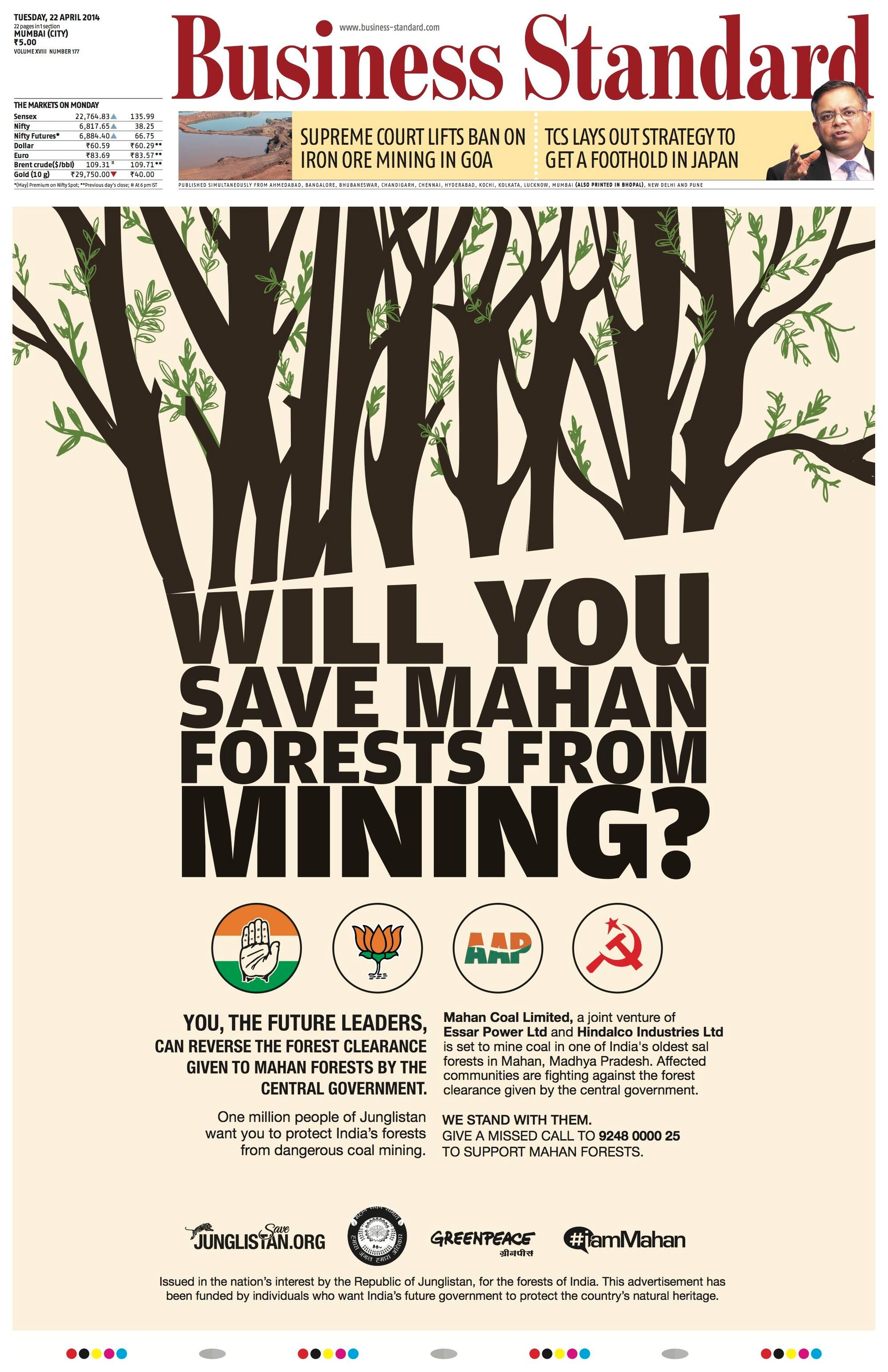Update: Greenpeace responds, saying, “The advertisement was also carried in the Bhopal edition of the newspaper. Till date, 1020 people have pledged money for the advertisement. Greenpeace India will continue to raise money till we meet our target of 10,50,000.” This morning’s Business Standard has an unusual front page jacket advertisement. Its’ not hawking a common-or-garden product or service, but it’s hawking a cause. It wants you to save the sal forests of Mahan. “One million people of Junglistan want you to protect India’s forests from dangerous coal mining,” the copy reads. “Mahan Coal Limited, a joint venture of Essar Power Ltd and Hindalco Industries Ltd is set to mine coal in one of India’s oldest sal forests in Mahan, Madhya Pradesh. Affected communities are fighting against the forest clearance given by the central government,” the ad goes on to say. Here is the ad:  Apart from the irony of the pointer to a story on an inside page that is headlined “Supreme Court lifts ban on iron ore mining in Goa”, many questions arise. Who has paid for the ad? Who or what is Junglistan? What has Greenpeace, whose logo appears in the ad alongside the Junglistan.org logo, got to do with this? Who is being targeted here? Why this strange media plan, with only Business Standard being chosen? A visit to Junglistan.org hardly educates. There is no ‘about’ section. The only functioning element on the homepage is a data capture form that urges you to sign in, support and donate toward the cause. And, of course, the target is now clearly in focus. “ESSAR: QUIT MAHAN!,” shouts the headline. “The pressure is on and Essar is getting closer to destroying forests in Mahan. Endangered wildlife, over 5 lakh trees, 14000 people- they all need you now! Sign up to Junglistan to join over a million in saving India’s forests. Join Junglistan. Be Mahan. Get Essar out!,” is the exhortation that follows. What else can we find out about the background of the strange Junglestan? A lot – if you check out the copyright section. Now it’s clear that Junglistan is only a device and that the campaign has been created and is owned by Greenpeace. Obviously a visit to the Greenpeace site is in order. Once there, we learn that, “One of the oldest sal forests of Asia - Mahan, Madhya Pradesh are facing the threat of an absolute wipe out. Giant corporations Essar and Hindalco are after the coal reserves below these forests. Over 14,190 lives and livelihoods are dependent on the Mahan forests, Madhya Pradesh. Their culture, community and lives are intertwined with the forests that the corporations threaten to destroy. Displacement from their natural habitat is going to be devastating for the indigenous community.” There’s no mention of Junglistan here, though. We have answers to most of the questions now. We know what Junglistan is, we know what Greenpeace’s role is, we know that Essar and Hindalco are the targets. What we do not know is who has paid for the ad. “Issued in the nation’s interest by the Republic of Junglistan, for the forests of India. This advertisement has been funded by individuals who want India’s future government to protect the country’s natural heritage,” is all that the ad says. However, their site says more. “Happy Earth Day! On April 22, lakhs of people including the political parties in Delhi, Mumbai, Kolkata and Ahmedabad will read about the fight for Mahan. This is thanks to the crowdfunded ad that was published in the Business Standard… The cost of publishing a full-page ad is Rs 10,50,000. So far we’ve only raised Rs 150,000. Can you chip-in Rs 420 (or more) for the ad about protecting Mahan? This amount can easily be raised if each person contributes Rs 420,” says an appeal. So we (sort of) know who is paying for the ad. It’s you –by paying Rs. 420 (an unfortunately chosen number, but it makes sense after the arithmetic of Rs.10,50,000 divided by 420, which yields a wonderfully round 2500 donors). One question left to be answered. Why Business Standard? The choice of a pink paper suggests that Greenpeace wants to target the business, professional and governmental communities and not lay consumers. If that’s the case, the messaging is off – and then the ad reeks of a corporate battle rather than an awareness campaign targeting sympathetic citizens. The editions that carry the ad do not include any city in Madhya Pradesh – and that just underlines the point.
This morning’s Business Standard has an unusual front page jacket advertisement. Its’ not hawking a common-or-garden product or service, but it’s hawking a cause. It wants you to save the sal forests of Mahan.
Anant Rangaswami was, until recently, the editor of Campaign India magazine, of which Anant was also the founding editor. Campaign India is now arguably India's most respected publication in the advertising and media space. Anant has over 20 years experience in media and advertising. He began in Madras, for STAR TV, moving on as Regional Manager, South for Sony’s SET and finally as Chief Manager at BCCL’s Times Television and Times FM. He then moved to advertising, rising to the post of Associate Vice President at TBWA India. Anant then made the leap into journalism, taking over as editor of what is now Campaign India's competitive publication, Impact. Anant teaches regularly and is a prolific blogger and author of Watching from the sidelines. see more


)

)
)
)
)
)
)
)
)



